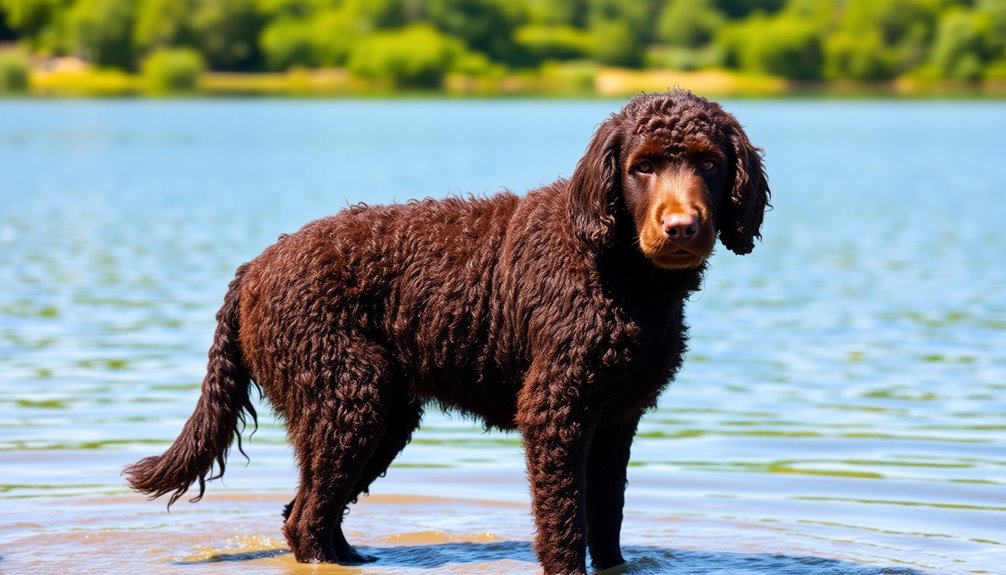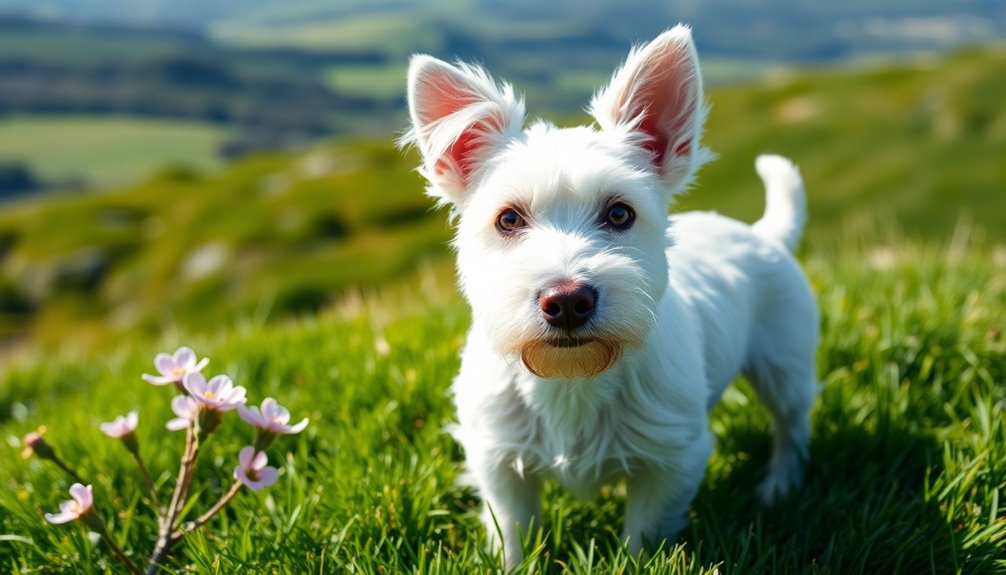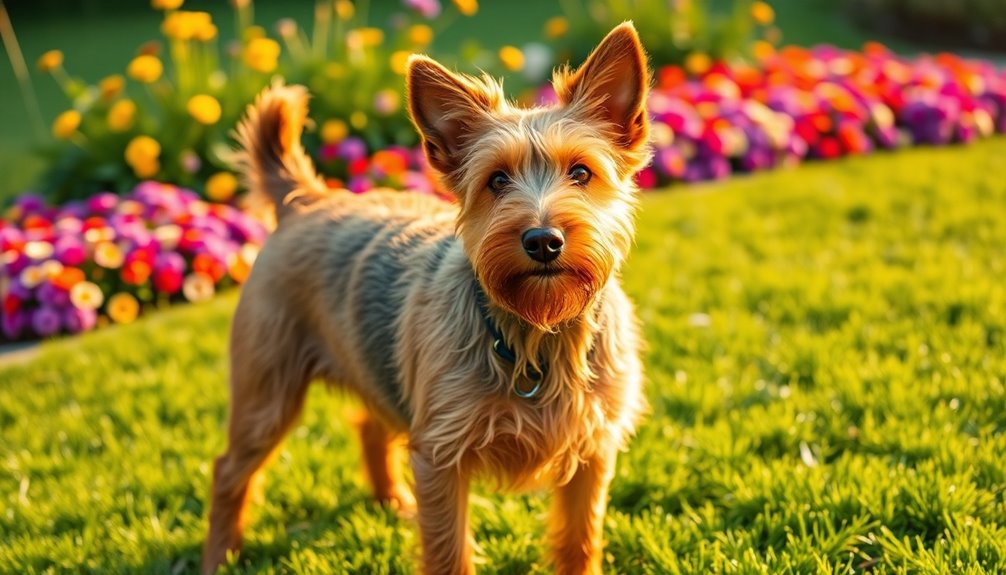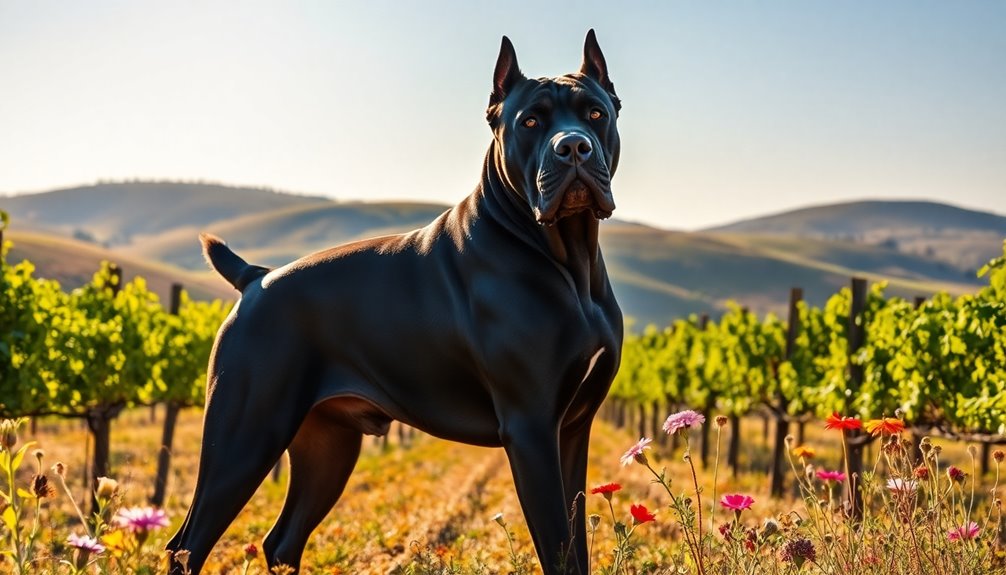The Irish Terrier is your bold and fearless friend, perfect for active families. Known for its loyalty and playful character, this breed thrives on human interaction and makes a great companion for children. Standing 18 to 20 inches tall, their distinctive fiery coat needs regular grooming. These terriers are energetic, requiring 60 to 90 minutes of exercise daily, and they excel in training with positive reinforcement. Their independent nature and high prey drive do demand some experience in dog ownership. Discover more about how to care for and connect with this exceptional breed in your journey ahead.
Key Takeaways
- Irish Terriers are known for their boldness and loyalty, making them fearless companions in family settings.
- They thrive on human interaction and require active engagement to be happy and well-adjusted.
- With a playful temperament, they are particularly good with children and can adapt well to family dynamics.
- Regular exercise and mental stimulation are essential to meet their high energy levels and prevent boredom.
- Their dense, wiry coat requires grooming every 4-6 weeks and minimal bathing to maintain its protective qualities.
Introduction
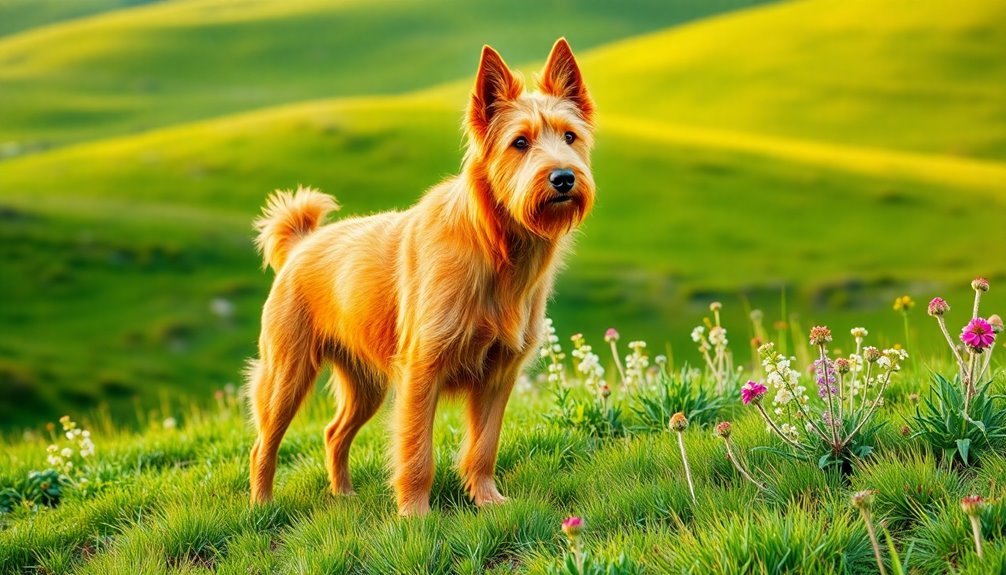
The Irish Terrier is more than just a dog; it's a bold and fearless companion ready to fill your life with joy and adventure. This breed brings a playful and lively spirit to your home, and its loving demeanor makes it a cherished family member.
With a strong, agile body and a wiry coat that can range from bright red to wheaten, the Irish Terrier isn't only beautiful but also well-suited for various activities. These dogs are incredibly loyal and people-oriented, often forming deep bonds with their owners. While they can have a stubborn streak, their bravery and determination shine through in everything they do.
With a high prey drive, they might chase after small animals, so keeping them engaged and exercised is crucial. Regular exercise and mental challenges will keep your Irish Terrier happy and healthy. Daily exercise needs of 60 to 90 minutes are essential to maintain their physical and mental well-being.
Though they can be reserved around strangers, their guarding instincts make them excellent watchdogs. Early socialization is key to ensuring your Irish Terrier interacts well with other dogs and pets.
History and Origin
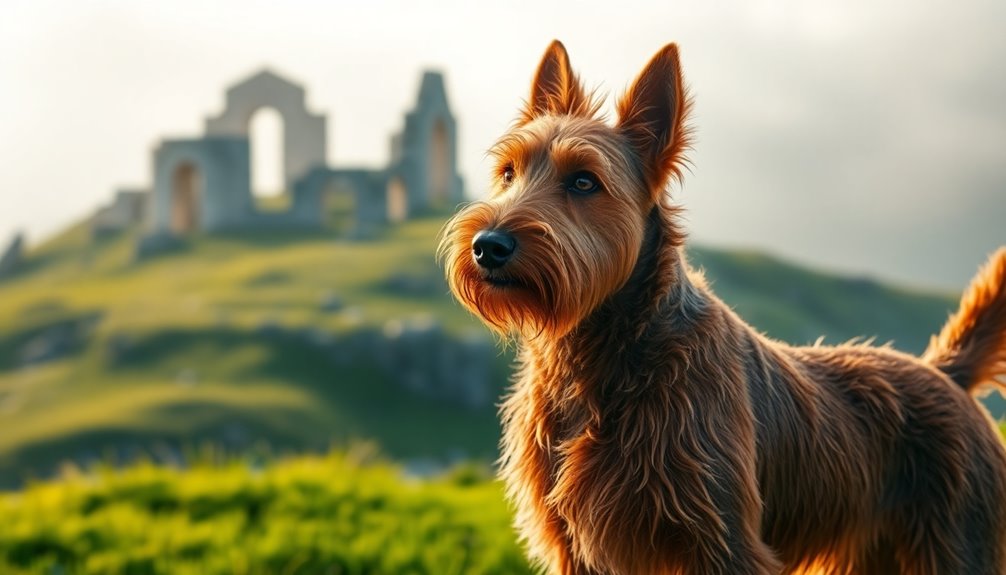
You might be curious about the origins of the Irish Terrier and how it became the breed we know today.
This fearless dog traces its roots back to Ireland, where it was primarily bred for hunting vermin like rats and rabbits. Its versatility on farms made it an invaluable companion, showcasing its skills long before it gained fame in dog shows. During its development, the breed was recognized as the first native Irish breed by the English Kennel Club.
Where and when the breed originated
Originating in Ireland, the Irish Terrier's exact timeline remains a mystery, with its roots tracing back to the black and tan terrier-type dogs of Britain and Ireland. This breed likely shares bloodlines with the Irish Wolfhound, adding to its rich heritage.
Initially, Irish Terriers came in various colors like black and tan, grey, and brindle, but by the late 1800s, the solid red color became predominant.
The formation of the breed began in earnest when the first breed club was established in Dublin in 1879. This club played a crucial role in defining the Irish Terrier as we know it today.
In 1873, the Dublin dog show introduced a separate class for Irish Terriers, paving the way for their recognition. Just before the end of the 19th century, the English Kennel Club officially recognized the breed, which was known by several names, including "Irish Red Terrier" and "Daredevil of the Emerald Isle."
As the breed spread geographically, the first Irish Terriers arrived in the United States in the late 19th century, quickly gaining popularity and establishing a global presence. Irish Terriers have been celebrated for their working qualities, particularly in vermin control, which further contributed to their desirability among dog enthusiasts.
Ratting and Vermin Control
Utilizing their keen instincts and agility, Irish Terriers have historically excelled in ratting and vermin control, making them invaluable to farmers in rural Ireland. These dogs weren't just companions; they were essential for maintaining farm hygiene by eliminating pests that threatened crops and livestock.
Small farmers relied on their multi-functional abilities, as they also helped with stock and guarded homesteads. The breed emerged from crosses between various terriers, early bull terriers, small Irish Wolfhounds, and shepherd breeds, focusing on enhancing their working capabilities. Many consider the Wheaten Terrier the original Terrier of Ireland, showcasing the breed's deep-rooted connection to the land.
In the early 1900s, the Kerry Blue Terrier's lineage was refined with Bedlington Terrier blood to improve performance. The Irish Kennel Club even established trials, such as the Teastas Beg and Teastas Mor, to test these dogs' ratting skills under challenging conditions.
Their reputation for bravery and loyalty grew during World War I, where they served as messenger dogs. The Irish Terrier's working ability and character earned recognition from breed authorities, solidifying their place in dog shows.
Physical Characteristics
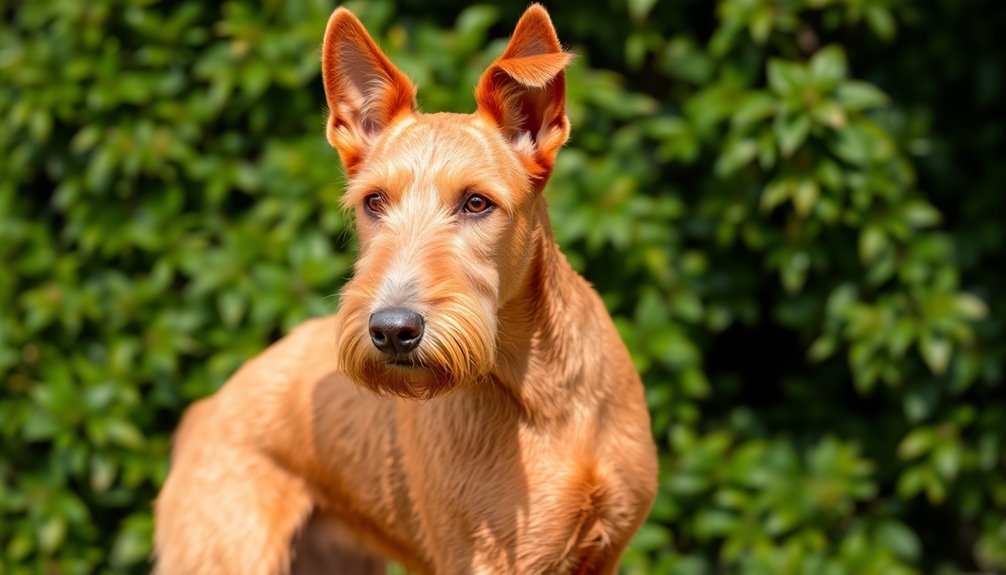
When you think of the Irish Terrier, picture a well-balanced dog standing 18 to 20 inches tall at the shoulder. Weighing between 25 to 27 pounds, these dogs are compact yet portable, making them great for various living spaces. Their distinctive dense, wiry coat, often in shades of golden red or wheaten, adds to their bold appearance and requires regular grooming to maintain. This breed is known for its high energy levels, so daily exercise is crucial for their physical and mental health.
Size, weight, and coat details
The Irish Terrier's striking physical characteristics make it a standout among dog breeds. Males typically stand between 17 to 18 inches tall at the shoulders, while females range from 16 to 18 inches, with some females reaching up to 19 inches. Occasionally, you might even encounter a male hitting 20 inches.
In terms of weight, males average around 27 pounds, whereas females weigh about 25 pounds. The acceptable weight range for males is 25 to 27 pounds, and for females, it's 24 to 27 pounds. Understanding breed characteristics aids in proper care, ensuring that their weight remains within these healthy guidelines.
The Irish Terrier boasts a well-balanced, symmetrical body with deep ribs that extend to the elbows. Its straight, muscular legs add to its athletic appearance, and the overall body length is proportionately longer than other terriers, measuring roughly 24 to 27 inches.
When it comes to coat color, the primary hue is a fiery red, though paler wheat and red wheaten mixes are also acceptable. Historically, they've appeared in black, tan, and gray.
The dense, wiry outer coat is complemented by a softer undercoat, which should be lighter in color than the outer layer, enhancing the breed's distinctive look.
Kinky, Wiry Coat Texture
While you admire the Irish Terrier's striking appearance, its unique coat texture is one of its most defining features. This breed boasts a dense and wiry coat that's never soft or silky. The hair has a broken appearance, lying close to the body, making it tough and resilient. When you part the hairs, you'll find that the skin is hardly visible, showcasing how tightly the hairs grow together.
Beneath this rough exterior lies a fine, soft undercoat, which is lighter in color and red. This undercoat supports the outer coat, enhancing its weather-resistant qualities. The hair on the back and quarters is particularly coarse, while the legs remain free of feathering, covered with hair similar in texture to the body. The face features short, almost smooth hair, and the tail is well covered with harsh fur. This breed's coat has been developed to provide excellent protection against harsh weather conditions.
To maintain this unique texture, you need to strip the coat rather than cut it. Stripping helps retain its color and weather resistance.
With minimal grooming required—just once or twice a year for pets—you'll ensure your Irish Terrier's coat stays in top condition.
Temperament and Personality
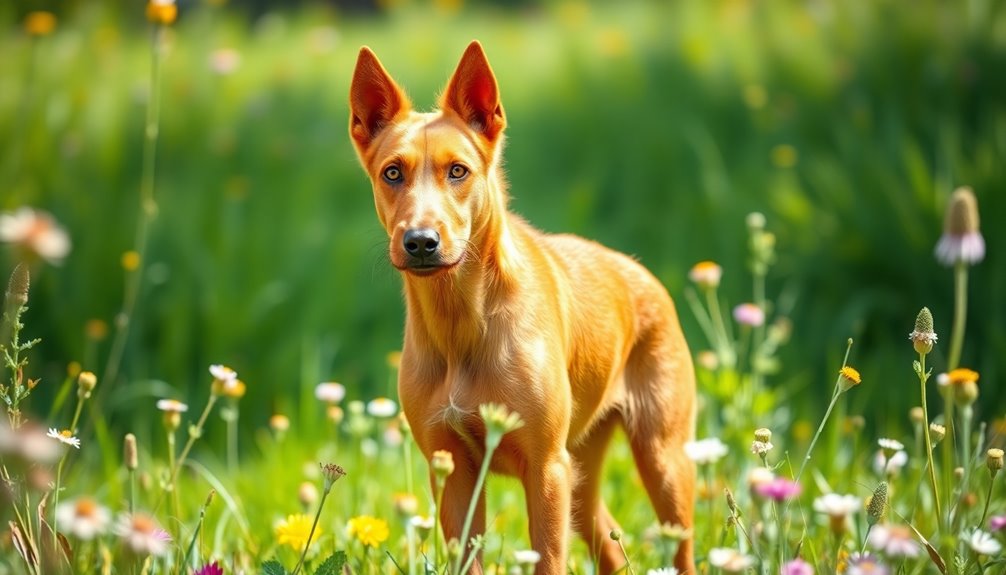
When you think of an Irish Terrier, picture a fearless and protective companion ready to stand by your side. Their bold nature makes them well-suited for families, individuals, and even households with other pets, as long as proper socialization is in place. With their loyalty and affection, you'll find them to be both a vigilant guardian and a loving friend. Additionally, their adaptability to various living conditions makes them an ideal choice for those seeking a dog that can thrive in different environments with proper care.
Fearless and Protective Nature
While independent thinkers, they can be stubborn, necessitating firm yet loving owners for consistent training. Incorporating mindfulness practices can also help strengthen the bond between you and your Irish Terrier. Positive reinforcement and lifelong education will help you cultivate their fearless and protective nature, resulting in a loyal and devoted companion. Additionally, their high energy levels require regular physical activities and mental stimulation to thrive.
Suitability for families, individuals, or other pets
The Irish Terrier's temperament makes it a fantastic choice for families and individuals alike, provided you can meet their needs. These dogs are affectionate and love children, making them great playmates when raised with kids. They thrive in active households where they can engage in daily walks and playtime. Additionally, they have a high energy level, which means they require plenty of physical and mental stimulation to stay happy and healthy.
However, they're best suited for families without other pets due to their high prey drive and potential for aggression towards other animals.
For individuals, Irish Terriers are independent thinkers who require consistent training and socialization. They respond well to challenges and enjoy being around people, making them lively companions. Their moderate exercise needs suit active singles with prior dog ownership experience.
When it comes to compatibility with other pets, be cautious. Their prey instincts often lead them to chase smaller animals, so it's not advisable to have them around cats or rodents. Early socialization can help, but their strong instincts may prevail.
Health and Lifespan
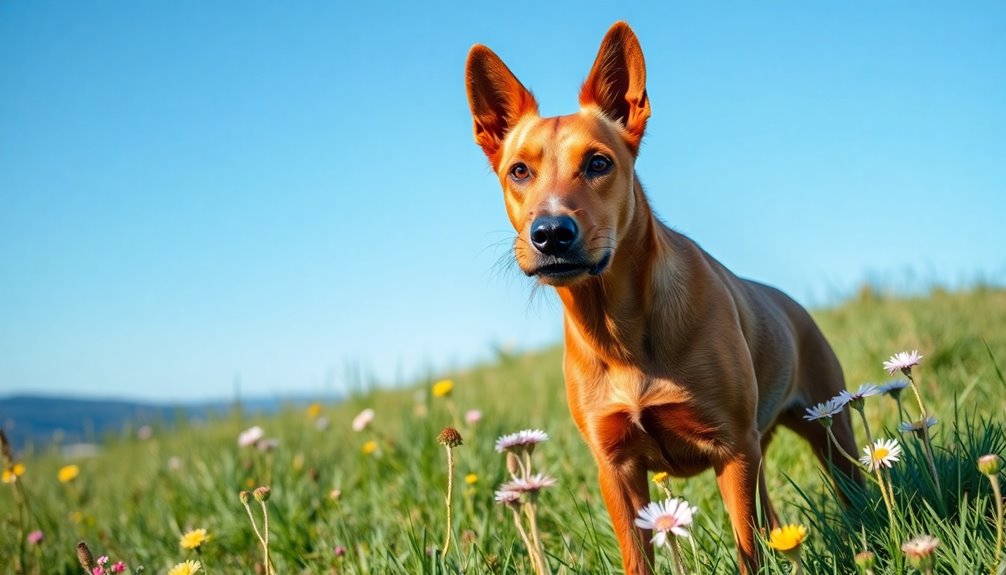
When you bring an Irish Terrier into your life, you can expect a lifespan of about 13 to 15 years, which means a long-term commitment. While they're generally healthy, they do have some common health concerns, including obesity and hip dysplasia, that you should keep an eye on. Staying proactive with regular vet check-ups and preventive care will help ensure your furry friend lives a happy and healthy life. Providing ample space for outdoor activities is also important for their overall well-being, as they thrive in an environment that allows for plenty of exercise.
Typical lifespan of the breed
Typically living between 13 to 15 years, the Irish Terrier showcases a lifespan that reflects its overall health and vitality as a medium-sized breed. This longevity is typical for dogs of their size, indicating that with proper care, they can be a part of your life for over a decade.
As you consider welcoming an Irish Terrier into your home, remember that their lifespan requires a long-term commitment to pet care. These dogs, weighing around 25 pounds for females and 27 pounds for males, need regular exercise and mental stimulation to thrive. Their energetic and intelligent nature makes them especially responsive to training, enhancing the bond you share. Additionally, incorporating a balanced diet is essential for their overall health and longevity.
Their well-balanced, muscular bodies and energetic spirits make them great companions for both country and city living, but they benefit greatly from a routine that includes physical activity.
Additionally, routine grooming for their wiry coats and regular veterinary check-ups are essential to keep them healthy and happy. By planning for their care and understanding the responsibilities involved, you can ensure that your Irish Terrier lives a fulfilling life, filled with adventures and companionship.
Embrace the journey, and you'll find that this bold and fearless friend will bring joy to your years together.
Common health concerns or genetic predispositions
Irish Terriers, like all breeds, come with their own set of health concerns and genetic predispositions that potential owners should be aware of.
One common issue is hypothyroidism, which can lead to dry skin, coat problems, and increased susceptibility to skin diseases. Additionally, be cautious of bladder or kidney stones, characterized by blood in the urine or straining while urinating.
Progressive Retinal Atrophy (PRA) is another concern, as it can cause blindness starting around three to five years of age. VKH syndrome, an autoimmune disorder, can affect the skin and eyes, worsening in sunlight. Regular veterinary check-ups are essential for early detection of these and other health issues.
Musculoskeletal issues like hip and elbow dysplasia can cause pain and mobility problems. Patellar luxation, where the kneecap slips out of place, is also common.
Infectious diseases like parvo and distemper pose a risk, underscoring the importance of vaccinations. Regular parasite prevention is crucial, as infestations can lead to serious health issues.
Lastly, dental health shouldn't be overlooked; dental disease affects many dogs, leading to significant complications if untreated.
Knowing these concerns will help you provide better care for your Irish Terrier.
Tips for maintaining health and wellness
Maintaining the health and wellness of your Irish Terrier is essential for ensuring a long, happy life. Start by scheduling regular veterinary check-ups, following the vaccination timeline based on your pup's age and needs. Annual blood screenings can help catch issues like hypothyroidism early on, so don't skip those appointments.
Feeding your Irish Terrier a balanced diet tailored to their age, size, and activity level is crucial. Stick to high-quality food and avoid giving too many human snacks or treats to prevent obesity and related health problems. Irish Terriers are known for being prone to allergies, so discussing any dietary concerns with your veterinarian is important.
Regular exercise is vital, too. Incorporate daily walks, playtime, and mentally stimulating activities like puzzle toys or training sessions to keep your pup engaged. Irish Terriers love water, so swimming is a fantastic way to expend energy!
Lastly, don't overlook grooming and hygiene. Brush their coat weekly, clean their ears, and maintain dental health by brushing their teeth at least twice a week.
Care Requirements
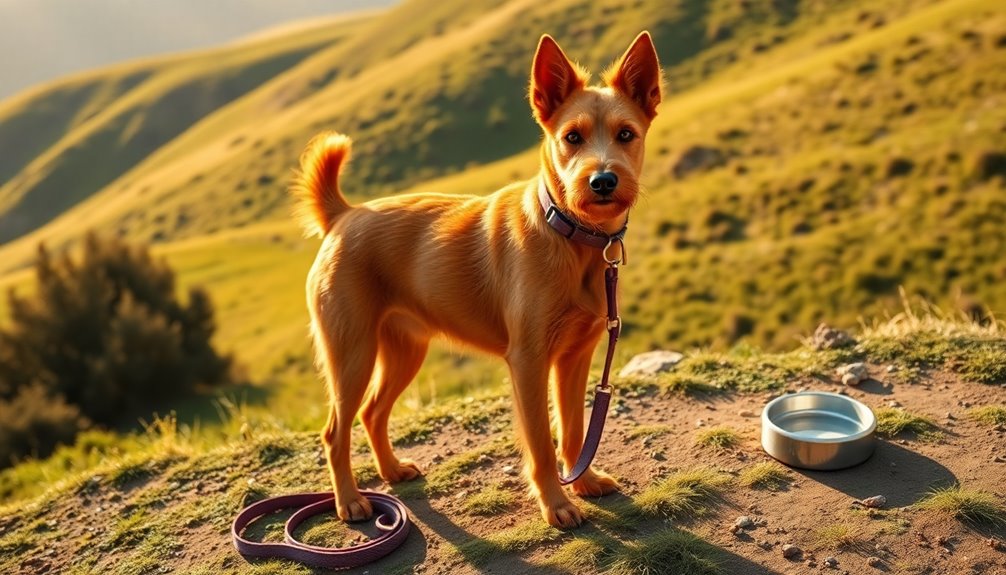
Caring for your Irish Terrier involves regular hand-stripping to keep their coat healthy and looking sharp. Additionally, these dogs have a strong build, making them naturally resilient to various health issues. You'll also need to ensure they get at least 1 to 1.5 hours of exercise daily to match their high energy levels. Plus, paying attention to their diet will help maintain their overall health and vitality.
Regular Hand-Stripping Required
To keep your Irish Terrier looking its best, regular hand stripping is essential. You should aim to do this every 4-6 weeks to maintain the coat's health and appearance. Hand stripping involves removing dead hairs from the outer coat by hand, so you'll need a stripping knife or comb. Remember to pull in the direction of hair growth while supporting the skin with gentle pressure.
Focus on plucking the longer hairs, which typically measure between 2-5 cm. Using finger cots or chalk powder can provide extra grip, making the process easier. Work steadily, removing only a few hairs at a time to avoid discomfort for your dog. Additionally, using a greyhound style comb can help with coat maintenance between stripping sessions.
Between stripping sessions, use a slicker brush to dematt the fur and clear out debris. Hand stripping not only prevents matting but also encourages new hair growth, resulting in a fuller, shinier coat.
This method is crucial for maintaining the breed standard, as clipping or scissor cutting can hinder growth and future hand stripping. Regular brushing is also necessary to keep your dog's coat clean and healthy, so make grooming a consistent part of your routine.
Exercise requirements and energy levels
For an Irish Terrier, regular exercise is crucial to keep their energetic spirit in check and promote overall health. You should aim for at least 1 to 1.5 hours of exercise daily, which includes 30 to 60 minutes of brisk walking or vigorous activities. This breed thrives on activities like jogging, fetch, and interactive play sessions. Engaging in agility training with household objects or specialized kits can also provide excellent physical and mental stimulation. Additionally, incorporating vigorous activities like swimming can offer a refreshing change and further enhance their fitness.
To ensure a safe and enjoyable experience, try to avoid summer evening flights when heading to dog-friendly travel destinations, as thunderstorms can disrupt plans. Incorporating fun games like hide and seek or tug of war encourages bonding while burning off energy. Socialization is key, so consider playdates at dog parks or with other canine friends.
Remember to tailor exercise to your dog's age and health; puppies need shorter, controlled play, while adults can handle more intense workouts. As your Irish Terrier ages, opt for gentler activities, but keep them moving regularly.
Don't forget mental stimulation! Puzzle toys, obedience training, and scent games are fantastic for keeping their minds sharp and preventing boredom.
Feeding tips and diet recommendations
Maintaining your Irish Terrier's health goes beyond exercise; a balanced diet plays a vital role too. Focus on a high-protein diet sourced from quality meats like beef, chicken, and fish. These proteins support your dog's overall health and daily energy needs. Incorporate essential fatty acids and omega-3s to enhance skin and coat condition. Additionally, a species-appropriate diet ensures that your dog receives the nutrition they are naturally suited for.
While protein is crucial, small amounts of carbohydrates from vegetables, herbs, and berries can provide valuable nutrients. Hydration is also essential; ensure your pup has access to fresh water and consider high-moisture foods as part of their diet.
For feeding schedules, puppies should eat three to four times daily, while adults thrive on two to three meals. Portion sizes should be adjusted based on your dog's age, size, and activity level, so consult the feeding charts on AAFCO-compliant dog food packaging.
Choose food that meets AAFCO standards for your dog's life stage and avoid kibble high in starchy carbohydrates. Look for natural, whole food diets with no fillers or artificial additives.
Customizing your dog's diet according to their specific needs will promote optimal health and vitality.
Training and Socialization
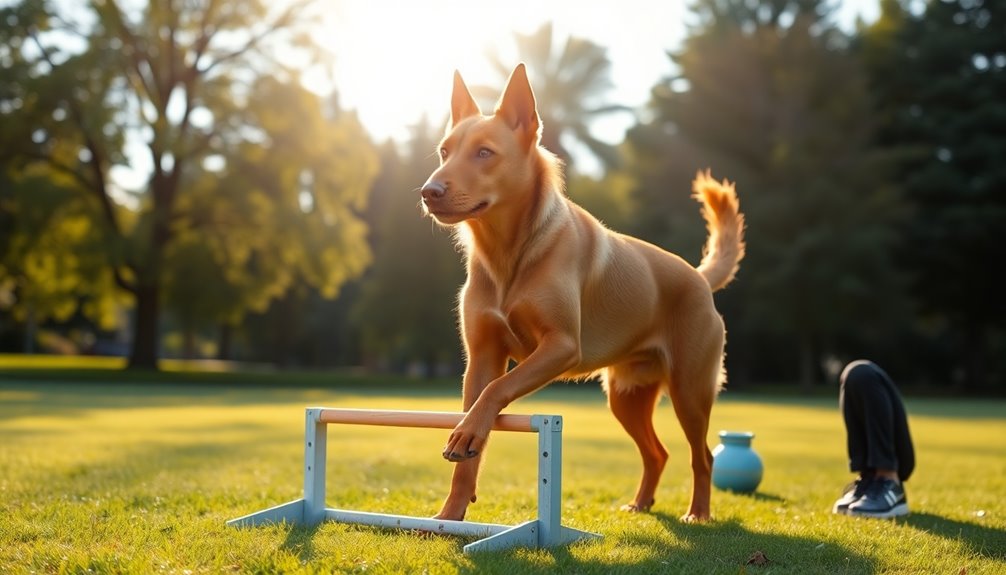
Training your Irish Terrier can be a rewarding challenge, given their moderately independent thinking. You'll want to gradually expose them to new environments to build their confidence and reduce any leash reactivity during walks. Incorporating positive reinforcement techniques, such as treats or praise when they respond to commands, will enhance their learning experience and strengthen your bond.
Moderately Independent Thinker
How can you effectively train an Irish Terrier, given their moderately independent nature? Start by leveraging their intelligence and eagerness to please. Use positive reinforcement techniques, rewarding them with treats, praise, or playtime to encourage desired behaviors. Additionally, incorporating routine health checks can help ensure they remain in good physical condition, which supports effective training.
Consistency is key; ensure that your commands and expectations remain clear to avoid any confusion. Keep training sessions short and engaging to match their active minds and prevent boredom. Since Irish Terriers are strong-willed, it's essential to be firm, yet gentle. Patience will be your best friend throughout this process, as it may take time for your pup to grasp commands fully.
Early socialization is crucial, so expose your Irish Terrier to various people, environments, and other dogs from a young age. This helps them develop friendly behavior towards strangers and other pets. Regular daily handling also contributes to managing their independent spirit. Additionally, incorporating consistent training practices into your routine can significantly enhance their learning experience.
Remember to use consistent tone and verbal cues, as this aids communication. Lastly, address common training challenges, like the command "Come," with persistence and creativity.
Regular exercise and mental stimulation will keep your Irish Terrier engaged, ensuring a well-rounded and happy companion.
Gradual Exposure to New Environments
When introducing your Irish Terrier to new environments, a gradual approach is essential for their comfort and confidence. Start by visiting quieter areas to prevent overwhelming them. Bring along familiar items like their favorite toy or blanket to create positive associations.
As you introduce new settings, closely observe their reactions, adjusting based on their comfort level. Reward calm behavior with treats and praise to encourage positive associations. Engaging your dog in familiar activities or games can boost their confidence and help them feel more at ease. Additionally, since elimination control develops post 4 weeks, it's crucial to ensure they have opportunities to relieve themselves during outings.
Positive reinforcement fosters a connection between you and your dog, making them more willing to explore. Monitor their body language and be patient; building adaptability takes time. Adjust the exposure process as needed, addressing any signs of stress or anxiety.
Consistency in your approach is key to nurturing a fulfilling relationship. Ultimately, gradual exposure not only helps prevent fear-based reactions but also strengthens your bond, enhances trust, and promotes adaptability to diverse environments.
Leash Reactivity During Walks
Leash reactivity can be a common challenge during walks, especially for Irish Terriers who are naturally bold and alert. Understanding your dog's reactivity threshold is essential. When your Irish Terrier is under threshold, they'll show loose body posture and take treats. However, if they go over threshold, they may become aggressive and find it hard to disengage from triggers.
Start by identifying what sets off your dog. Keep a safe distance from triggers to prevent stress, and remain calm yourself—your energy influences their behavior. It's important to recognize the signs of being over threshold to effectively manage your dog's reactions. Additionally, incorporating a high-quality protein source in their diet can support their overall health and energy levels during training.
Use techniques like rewarding eye contact and practicing impulse control, gradually introducing distractions like other dogs. Consistency is key; make sure you're clear with commands and expectations to avoid confusion.
Consider using a properly fitted harness to manage pulling, and practice good leash handling skills. Carry training treats to reward good behavior.
If your dog reacts, step back and create space, rewarding calmness as you desensitize them to the trigger. With patience and proper training, you can help your Irish Terrier enjoy walks without the stress of reactivity.
Ideal Living Environment
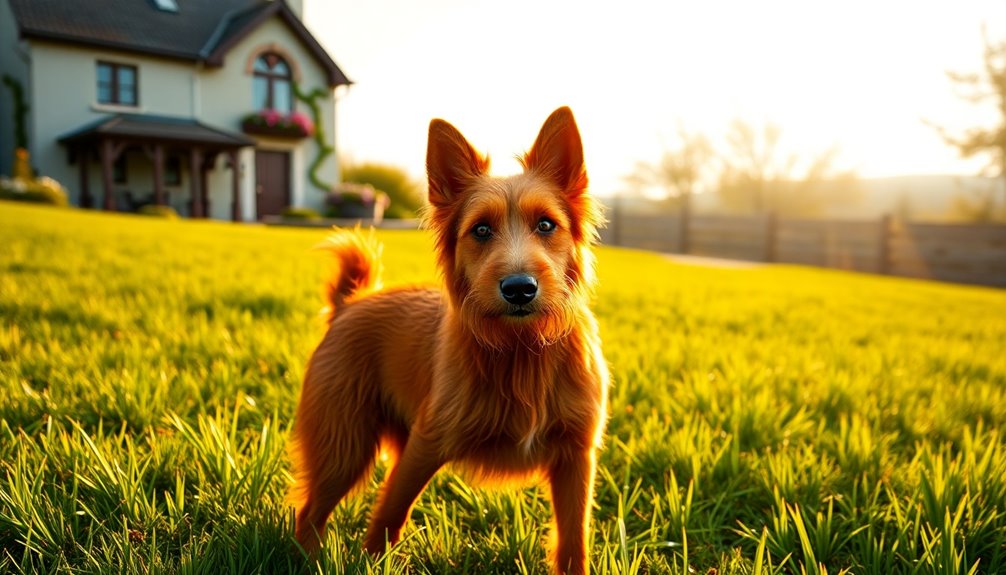
To keep your Irish Terrier happy and healthy, a house with secure fencing is essential for their playful spirit. They can adapt to colder weather thanks to their wiry coat, but you'll want to ensure they're protected during extreme conditions. Providing a safe space and considering their climate needs will help your bold friend thrive. Additionally, regular exercise requirements such as walks and playtime are crucial for their overall health and happiness.
House With Secure Fencing
A secure yard is essential for your Irish Terrier, as it provides a safe space for them to play and explore. Aim for a minimum fence height of four feet, using sturdy materials like chain link, wood, or woven steel. Make sure the construction prevents your dog from jumping or digging under the fence. Regularly inspect the fencing to keep it in good condition and free from hazards.
While your Irish Terrier enjoys the freedom of a fenced yard, don't leave them unsupervised for extended periods. They thrive on human interaction and may become destructive if left alone. Ensure the fence allows your dog to see their surroundings, which can help reduce anxiety and boredom. Solid panels or closely spaced slats work well to eliminate gaps.
Consider the ground clearance; the fence should be low enough to prevent digging. Smooth surfaces without sharp edges are also crucial for safety. Additionally, make sure to follow the minimum age requirement for potential adopters to ensure a responsible and caring environment for your new companion.
Finally, check for any restrictions from housing associations regarding fencing. By investing in secure fencing, you create a haven for your Irish Terrier, allowing them to run and play safely while enjoying the outdoors.
Cold Weather Adaptability
Providing your Irish Terrier with a secure yard sets the stage for a happy and active lifestyle, but it's also important to consider how they adapt to cold weather. With their dense double coats, Irish Terriers are well-equipped to handle chilly conditions. This insulation not only helps retain body heat but also repels moisture, keeping them warm and dry during snowy outings. Additionally, their thick footpads are designed to resist freezing, providing essential mobility in harsh conditions. The unique structure of their coat can significantly contribute to their overall respiratory health, as it protects them from extreme weather conditions.
While they tolerate cold weather well, you should still take precautions. For extended outdoor exercises, consider using protective booties to shield their paws from ice and salt. If temperatures drop drastically, a jacket can offer extra warmth. It's essential to monitor their comfort level during outings—shorter excursions are key when it's particularly frigid.
Additionally, ensure your dog has access to a cozy, insulated shelter when outside. If the weather is severe, bring them indoors to a warm space.
Adjusting their diet to provide extra calories during winter can help meet their energy needs. By taking these steps, you'll keep your Irish Terrier comfortable and happy, ensuring they thrive even when the temperature drops.
Unique Hunting Skills
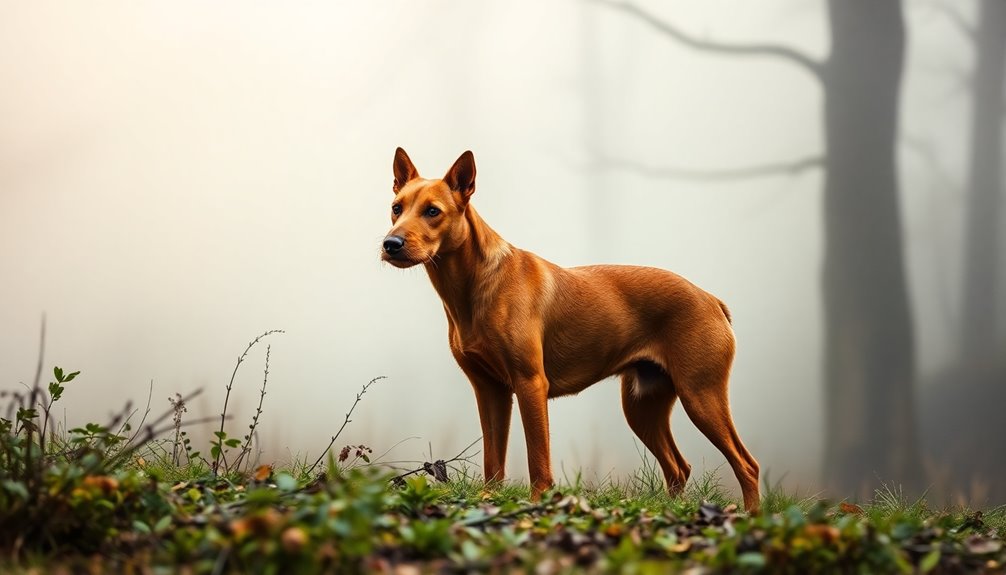
When you think of unique hunting skills, the Irish Terrier stands out with its exceptional water retrieval abilities. These dogs not only excel in fetching game from water but also played a crucial role during World War I as messenger dogs. Their versatility and courage make them invaluable companions in various hunting scenarios. However, they are considered less suitable for hunting compared to other breeds.
Exceptional Water Retrieval Abilities
The Irish Terrier shines with its exceptional water retrieval abilities, making it a standout among hunting breeds. This breed has a natural love for water, similar to retrievers, which enhances its proficiency in retrieving from aquatic environments. With proper training, your Irish Terrier can become an adept water retriever, showcasing its soft mouth that's perfect for bringing back game birds without damaging them.
These dogs are excellent swimmers, capable of keeping pace alongside boats, which is a remarkable trait when enjoying a day out on the water. Their natural affinity for hunting around water and swamps allows them to excel in retrieving tasks, whether it's birds or other small game. The Irish Terrier's adaptability to various environments further enhances its ability to thrive in diverse hunting conditions.
The Irish Terrier's coarse coat protects it from punctures and abrasions in dense environments, making it well-suited for both land and water activities. Their extraordinary speed, grace, and endurance further elevate their performance as hunters.
When you have an Irish Terrier by your side, you're not just welcoming a companion; you're gaining a tireless partner that thrives in water, ready to retrieve and make your hunting experiences truly memorable.
World War I Messenger Dog
Irish Terriers played a vital role as messenger dogs during World War I, showcasing unique skills that set them apart from other breeds. Their intelligence, spirit, and faithfulness made them indispensable on the battlefield. Trained at the British War Dog School, these dogs effectively delivered messages between the front lines and headquarters, often carrying them in tin cylinders attached to their collars.
Their remarkable resilience shone through even in harsh conditions. Irish Terriers navigated complex terrains with ease and demonstrated extraordinary sensitivity and reliability under stress. You'd appreciate their independence, allowing them to operate without constant supervision, which was vital in chaotic environments. Many of these dogs had the ability to overcome physical obstacles, which was crucial for their success in delivering messages amidst challenging battlefields.
These dogs not only ran messages back to their handlers but also adapted to act as liaison dogs, showcasing their versatility. Training helped them acclimate to various conditions, enabling them to analyze situations effectively.
Historical accounts highlight their bravery, with many soldiers attributing their survival to these loyal companions. Despite facing danger, including gas attacks and injuries, Irish Terriers continued to deliver crucial messages, reinforcing their reputation as bold, fearless, and loyal friends in times of war.
Active Lifestyle Compatibility?
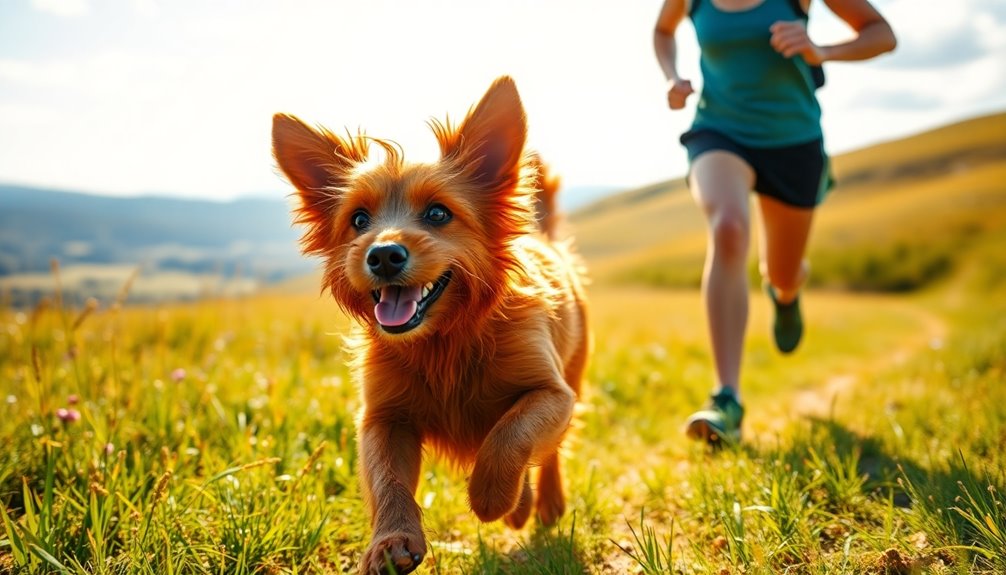
If you lead an active lifestyle, the Irish Terrier can be your perfect companion. They thrive on exercise and enjoy a variety of activities, making daily walks and playtime essential for their happiness. However, keep in mind their grooming needs and the commitment required to maintain their energetic nature. Additionally, regular physical activity is necessary to keep dogs healthy and prevent obesity-related conditions.
Energetic Companions for Active Owners
For those who lead an active lifestyle, finding a dog that can keep up with your energy levels is essential. An Irish Terrier is an ideal companion, needing at least 30 to 60 minutes of vigorous exercise daily.
Whether you prefer brisk walks, jogs, or engaging in activities like agility training and fetch, these dogs thrive on physical activity. They require regular movement to burn off energy and maintain their physical and mental well-being. Irish Terriers are also known for their strong instinct for herding and hunting tasks, making them highly adaptable to various environments and activities.
Irish Terrier puppies are bundles of energy, needing frequent play and short walks, while adults benefit from more structured exercise sessions.
Even senior Irish Terriers need gentle activities but still require regular movement to stay happy. With their high energy levels, they're not satisfied with short, casual walks.
These dogs excel in various weather conditions and can even pull significant loads, showcasing their strength.
Whether you enjoy hiking, running, or socializing at dog parks, Irish Terriers make wonderful partners. They also benefit from mental stimulation through puzzle toys and scent games.
If you're an active owner, an Irish Terrier could be the perfect match to accompany you on all your adventures!
Grooming Needs and Commitment
Finding a dog that matches your active lifestyle means considering not just exercise needs but grooming requirements too.
The Irish Terrier's wiry coat requires specific grooming techniques, primarily hand stripping every 4-6 weeks. This process removes dead hairs, prevents matting, and encourages healthy coat growth. You'll need a stripping knife or comb, ensuring the edge is dulled to avoid skin cuts. Regular grooming is essential to maintain the coat's health. Additionally, engaging in regular physical activities with your dog can significantly enhance emotional well-being for both you and your pet.
Weekly brushing is essential to keep the coat tidy, but don't worry too much about shedding; their double coat minimizes it. Bathing should be infrequent, using mild products made for harsh-coated breeds, followed by a thorough rinse and towel drying.
Regular care extends beyond the coat.
You'll need to brush their teeth 2-3 times a week, trim their nails every 2-3 weeks, and check their ears and eyes for any issues.
Frequently Asked Questions
Are Irish Terriers Good With Children and Other Pets?
Irish Terriers can be great with children, as they're gentle and sturdy enough to handle their energy.
However, they thrive with active kids and can get bored with quieter ones.
When it comes to other pets, though, they're often not as compatible. Their strong prey drive may lead them to chase smaller animals, and they can be territorial with other dogs.
Early socialization is key, but they might do best as solo pets.
How Much Grooming Do Irish Terriers Require?
Irish Terriers require regular grooming to keep their double coat healthy.
You should brush them at least once a week to remove dirt and loose hair. Hand stripping every 4-6 weeks helps maintain the wiry outer coat.
Bathing should be done occasionally with a mild shampoo, and don't forget to trim their nails every 2-3 weeks.
Regular dental care and ear cleaning are also important to ensure your dog stays healthy and happy.
What Is the Average Cost of an Irish Terrier?
The average cost of an Irish Terrier puppy ranges widely based on your location.
In the Northeast, you might pay between $1,500 and $2,500, while the Southeast typically sees prices from $1,200 to $2,000.
In the Midwest, expect to spend around $1,000 to $1,800, and in the West, prices can soar to $2,000 to $3,000.
Always consider the breeder's reputation and puppy lineage when making your decision.
Do Irish Terriers Have Any Common Behavioral Issues?
Yes, Irish Terriers can have several common behavioral issues.
You might notice them being rambunctious, especially when they're young. They've a strong prey drive, so they may chase after running objects.
If not properly socialized, they can show dominance or aggression towards other dogs.
Digging and escaping can also become a problem.
To prevent these behaviors, early training and consistent mental stimulation are essential, along with positive reinforcement techniques.
Can Irish Terriers Adapt to Apartment Living?
Yes, you can have an Irish Terrier in an apartment, but it's essential to meet their exercise and mental stimulation needs.
Regular walks and playtime are crucial, along with daily outdoor activities. They thrive on social interaction, so make sure they live indoors with you and your family.
While they can adapt, having a yard would provide them with the ideal space for exercise and exploration, helping to keep them happy and healthy.
Conclusion
In conclusion, the Irish Terrier is a bold and fearless companion that thrives on adventure and companionship. With its unique hunting skills and active lifestyle compatibility, this breed is perfect for those who love the outdoors. You'll appreciate their loyalty and spirited personality, making them an ideal friend for an active lifestyle. Just remember to provide proper training and socialization to ensure your Irish Terrier remains a well-rounded and happy member of your family.


